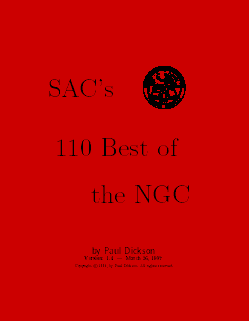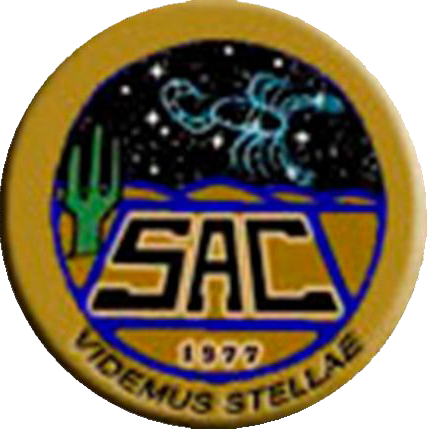
The book is currently available for online use,
and is presented for free usage when used on-line (3.6MB)
Printing Recommendations:
This book was originally printed with red covers (similar to the image shown, although slightly lighter).
The first page in the PDF file is the front cover and a blank back cover was added.
The book was originally 3-hole punched; some copies were spiral bound.
If you have further questions, feel free to send E-mail.
The Saguaro Astronomy Club (SAC) has maintained an observing list called the 110 Best of the NGC since 1990. This list is a derivative of the work found in the RASC Observer’s Handbook, with brighter – although more southerly – objects added to the list.
Over the course of 18 months, ending in 1996, I made many finder charts to help me locate each object, but I had to discard the first two generations due to their not being very helpful. On the third iteration I hit a useful design. So useful, I decided to add the fifteen objects I had already observed to complete the book. After soliciting comments from local observers, I had a nice book.
I thought that since this was a SAC observing list, there would not be much demand outside of our club. Events have proved to me that this isn’t the case. I’ve approached four other Arizona clubs in the first six months of selling the book. More than 70% of the books sold were to those clubs. And they’re still buying.
SAC’s 110 Best of the NGC is a 124-page, three-hole punch book. It is loose-leaf so more paper can be added or pages removed for an observing session. The objects are sorted numerically within each constellation. Each constellation has a chart for locating the position of each object and the each object is presented in a chart 6° on a side with stars down to magnitude 9. For each object the U2000 and Tirion charts numbers and the NGC descriptions are given. Also given are referencing page numbers from Burnham’s Celestial Handbook, Observing Handbook and Catalogue of Deep-Sky Objects, and the Deep Space CCD Atlas.
The sky-maps in this book were generated using David Chandler’s Deep Space program.
Here are three sample pages from the book. Click on each image to see a larger image:

Example1
Example2
Example3
The book is separated alphabetically by constellations. This allows for easy grouping of objects based upon what’s up. When you want to observe in Orion, you can leave Scorpius in the notebook. If your notes for other objects are grouped by constellation, you can add them to this book or you can add the book to your notes.
At the beginning of each constellation is a chart with Telrad circles for each object. A few objects share a Telrad circle when they are very close together. The stars are plotted down to magnitude 6.5.
The Messier objects and other objects from this list are plotted for other constellations, but Telrad circles aren’t given for them.
Within each constellation, the objects are listed in numerical order. Each object has a finder chart plus a little information from the SAC Deep-Sky Database.
There are page numbers given to other references such as Uranometria and Tirion if you need further help locating an object. Also given are references found in Observing Handbook and Catalogue of Deep-Sky for a visual description of the object, Burnham’s Celestial Handbook for information about the object, and the Deep Space CCD Atlas for an image that compares well with what you will see visually.
There is space available for the user to log personal notes about the object while observing. At the beginning of the book is space for writing information about the observing session.
An index is included which lists all the names of the objects alphabetically and gives the page number where they can be found.
I hope I’ve covered everything, if I haven’t or if you have further questions, feel free to send E-mail.
-Paul Dickson
Saguaro Astronomy Club


